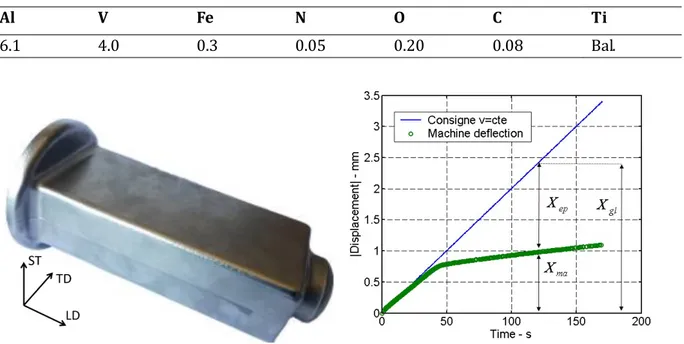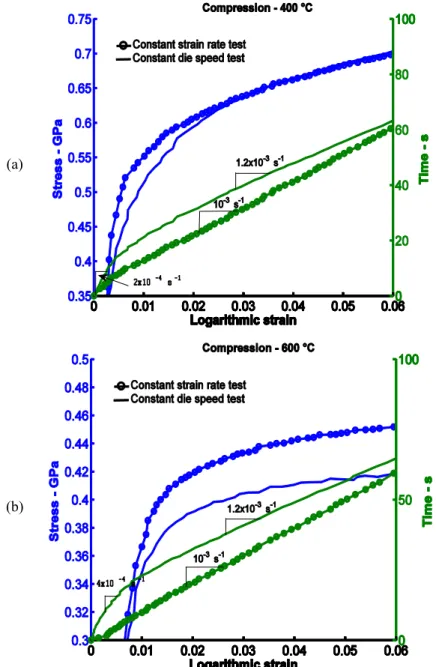CSMA 2019
14ème Colloque National en Calcul des Structures 13-17 mai 2019, Presqu’île de Giens (Var)
Effect of small strain rate variations on the identification of the
compressive behaviour of Ti6Al4V
V. Tuninetti1, P. Flores2, C. Medina2, L. Duchêne3, A. M. Habraken3,4
1 Department of Mechanical Engineering, Universidad de La Frontera, Chile, victor.tuninetti@ufrontera.cl 2 Department of Mechanical Engineering, Universidad de Concepción, Chile, {pfloresv,cmedinam}@udec.cl. 3 ArGEnCo Department, MSM Team, University of Liège, Belgium, {anne.habraken,l.duchene}@uliege.be 4 Fonds de la Recherche Scientifique – F.N.R.S.–F.R.S., Belgium
Abstract — Ti6Al4V is an hcp material that exhibits a strain rate sensitive behaviour and the tension compression asymmetry yielding known as the Strength Differential (SD). To quantify the SD effect of this alloys, initial yield compressive stress at different temperatures are computed by performing two type of tests, the conventional constant die speed and the constant strain rate compression tests. The results show the effect of the small strain rate variations on the initial yield stress and the strain hardening of the alloy at moderated temperatures.
Keywords — yield stress, material indentification, constant strain rate, strain sensitive material, Ti64.
1. Introduction
The plastic characterization of the Ti6Al4V alloy involves the identification of an initial yield locus, and its evolution with the plastic work, the temperature and the strain rate. Several models representing the strain rate sensitive behaviour of this hcp alloy are available in the literature, for instance, Zerilli–Armstrong [1], Norton–Hoff [2] and the most widely used Johnson–Cook [3-5] material model. Other advanced models as the one developed by Cazacu et al. [6] with a distortional hardening allows the description of material anisotropy and Strength Differential (SD) effect. The mechanical tests required to accurately identify or validate these material models of the material should be performed at constant strain rates and constant temperature.
Galán López et al. [7] demonstrated that tests performed at constant sample temperature are required for the accuracy of the stress modelling. The temperature increase due to heat generation of the sheet Ti6Al4V tensile samples tested in air, influences the strain hardening response due to the thermal softening.
For tensile and compressive constant strain rate tests, universal testing machines are equipped with a closed–loop control system [8]. Nevertheless, in many laboratories, this feature is not always available in the machines. The capability of machines to be configured with a proper user–defined displacements of the cross–head is used in this research to perform constant strain rate compression
2. Material and experimental procedure
The bulk forged Ti6Al4V alloy shown in Figure 1 is tested under compression at the LD material direction. Its chemical composition is given in Table 1. A servo-hydraulic testing machine controlled for both constant strain rate and constant cross-head speed tests is used to perform compression tests on elliptical samples as the ones proposed in Tuninetti et al. [9]. The machine is equipped with an infrared furnace (Quad Ellipse Chamber, Model E4, Radiant Energy Research Inc.) to apply compression test on samples at 400°C and 600°C. Prior to the tests, the samples were held for 10 min at the testing temperature in order to ensure a homogeneous temperature distribution through the specimens.
Equation 1 allows computing the height increase or reduction
X
ep
t
of the specimen (note that negative value is associated with compression) as a function of time necessary to impose on the sample for a test at a constant strain rate
.H
0 is the initial height of the specimen. ThisX
ep
t
value could be used as the user–defined displacement of the actuator only if the displacement is imposed according to an extensometer directly applied on the specimen. This case is usual for the tests performed at room temperature (RT) with the tensile testing machines. Imposing the user–defined displacement computed with Equation 1, one can reach a constant strain rate test.However, high temperature extensometers for tensile tests are not currently available in many laboratories. Besides, in the testing machine used for compression tests, the sensor associated to the user–defined displacement is connected in the actuator (cross–die). The rigidity of the machine should be first identified and considered in order to impose the proper displacement or deformation of the specimen for the constant strain rate tests.
t
H
0
exp
t
1
X
ep
(1)Imposing a cross–head global displacement
X
gl
t
with the purpose of reaching a specific specimen displacementX
ep
t
needs a previous knowledge of the machine deflectionX
ma
t
(Figure 1b). This deflection could be measured during the test of a sample with a specific material, however
t
X
ma depends on the load applied by the machine, which also depends on the strain rate sensitivity of the material. To reach a constant strain rate test, a closed–loop control feature could be used [8]. A second option, which is used in this research, is to perform a consecutive series of tests with the proper user–defined displacement of the actuator until a constant strain rate test is reached.Table 1 – Chemical composition of the bulk forged Ti6Al4V alloy investigated.
Al V Fe N O C Ti
6.1 4.0 0.3 0.05 0.20 0.08 Bal.
Figure 1. (a) Bulk Ti6Al4V alloy and (b) deflection of the machine (SCHENCK Hydropuls 400 kN press) and Ti6Al4V specimen deformation in a constant cross–head speed test (test 1) at
v
0
.
021
mm/s.3. Assessment of the compressive strain rate sensitivity of Ti6Al4V
The compressive stress–strain responses of the two types of tests performed on Ti6Al4V at 400 °C and 600 °C are compared (Figure 2):
1. The first type of test is performed at constant die (cross–head) speed knowing the targeted strain rate equal to 10–3 s–1. Two merely constant strain rates for the plastic range (around to 1.2x10–3
s–1) and the elastic range (around to 10–4 s–1) can be observed for the two studied temperatures
(Figure 2).
2. The second type of test is performed at a constant strain rate equal to 10–3 s–1 by applying the
(a)
(b)
Figure 2 – Comparison between stress–strain curves of compression tests at constant die speed and constant strain rate at (a) 400 °C and (b) 600 °C.
The difference between the yield stress level for a test at a constant strain rate and at a constant cross–head speed is higher at 600°C degres. As observed in Figure 2 and Figure 3, the variation in the strain rate can lead to a large inaccuracy in the estimation of the proper initial yield stress of the alloy and the initial strain hardening rate for a targeted strain rate at moderated temperatures. For room temperature tests, negligible differences in the stress–strain response for the two different test conditions has been observed. These findings on the material response are qualitatively similar to the response reported on other metals [10].
(a) (b)
Figure 3 – Comparison between the evolution of the strain hardening rate
y yp
with the yield stress y
of compression tests at constant die speed and constant strain rate at (a) 400 °C and (b) 600 °C.
yp is the accumulated axial plastic strain.4. Conclusion
The effect of small strain rate variations on the strain hardening rate and the initial yield stress of Ti6Al4V was presented for temperatures equal to 400°C and 600°C. The compressive behaviour was selected in this study, and the capability of machines to be configured with proper user–defined displacements of the cross–head was used to perform constant strain rate and constant cross-head speed compression tests. The importance of using accurate method for the characterization of the strain rate sensitivity of the Ti6Al4V alloy was also highlighted. The experimental results showed that significant variations of the mechanical features of the alloy can be found at moderated temperatures if constant strain rate is not reached for the full range of strain. These findings should be considered in order to accurately identify the constitutive laws modelling the mechanical behaviour of the studied alloy.
Acknowledgements
The authors thank the Chilean Scientific Research Fund CONICYT FONDECYT 11170002, the Universidad de La Frontera internal Research Found DIUFRO (Project DI17-0070), cooperation WBI/AGCID SUB2019/419031 and the Belgian Scientific Research Fund FNRS for financial support. The authors would also like to thank O. Milis for its technical support.
[5] J. Peirs, P. Verleysen, J. Degrieck. Novel Technique for Static and Dynamic Shear Testing of Ti6Al4V Sheet. Exp Mech 52, 729–741, 2012. https://doi.org/10.1007/s11340-011-9541-9.
[6] O. Cazacu, B. Plunkett, F. Barlat. Orthotropic yield criterion for hexagonal close packed metals. Int. J. Plasticity 22, 1171–1194, 2006. https://doi.org/10.1016/j.ijplas.2005.06.001.
[7] J. Galán López, J. Peirs, P. Verleysen, J. Degrieck. Effect of small temperature variations on the tensile
behaviour of Ti-6Al-4V, Procedia Engineering 10, 2330-2335, 2011.
https://doi.org/10.1016/j.proeng.2011.04.384.
[8] C. S. Hartley, D. A. Jenkins. Tensile Testing at Constant True Plastic Strain Rate, JOM 32, 23-28, 1980. https://doi.org/10.1007/BF03354560.
[9] V. Tuninetti, G. Gilles, O. Milis, L. Lecarme, A.M. Habraken. Compression test for plastic anisotropy characterization using optical full-field displacement measurement technique, Steel Research International S.E: 14th Int. Conf. Metal Forming, 1239-1242, 2012.
[10] P. Li, C. R. Siviour, N. Petrinic. The Effect of Strain Rate, Specimen Geometry and Lubrication on Responses of Aluminium AA2024 in Uniaxial Compression Experiments. Exp Mech 49, 587–593, 2009. https://doi.org/10.1007/s11340-008-9129-1.


